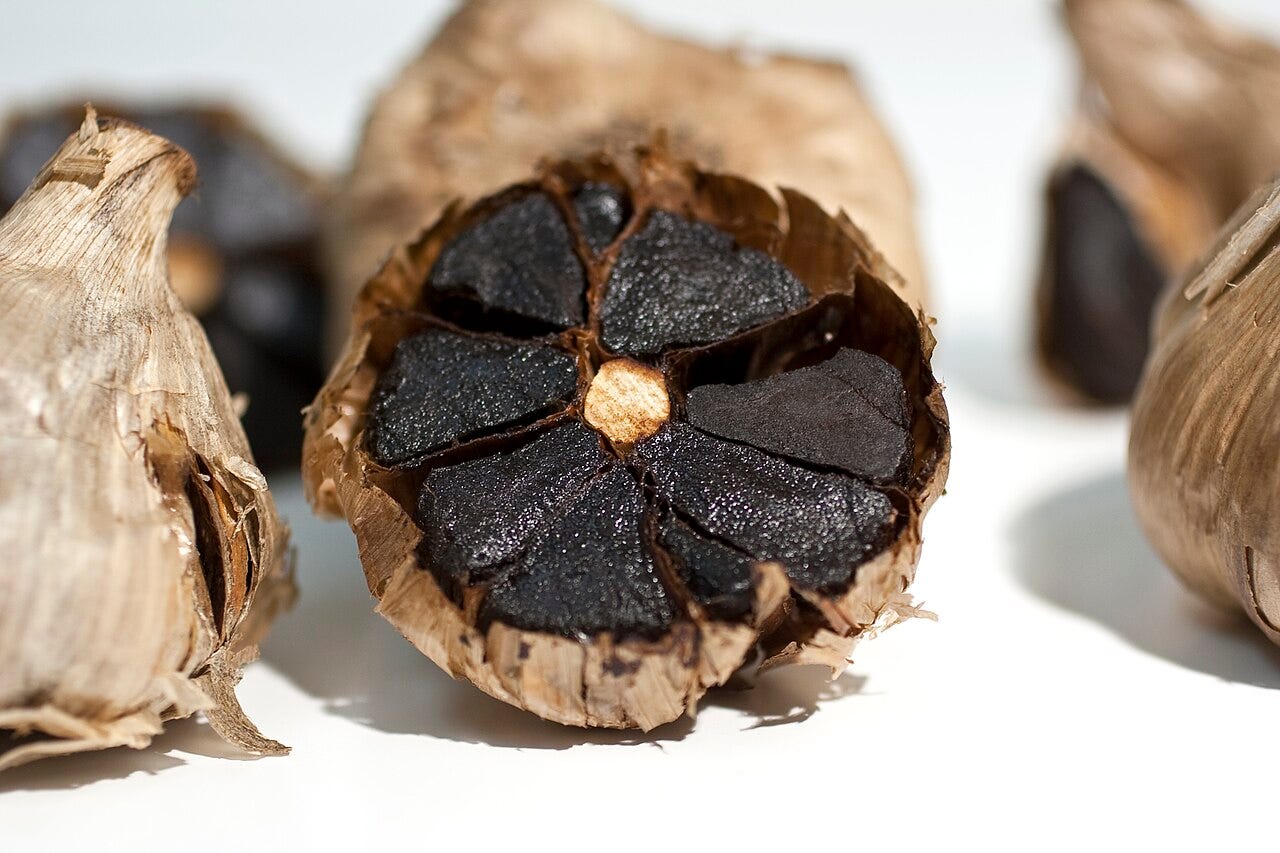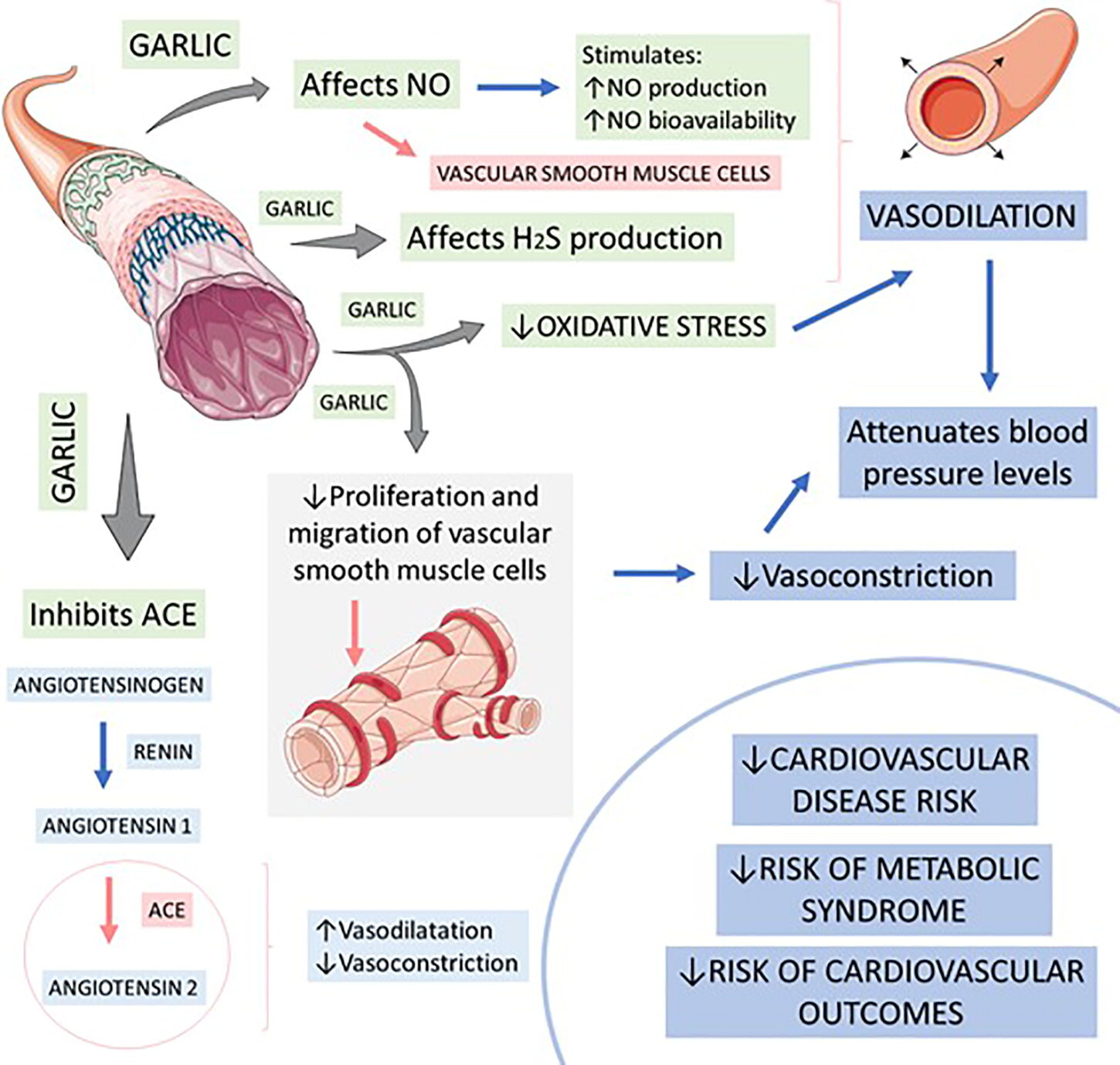Garlic for your Heart
Studies on garlic have shown many benefits for prevention of cardiovascular disease.
Garlic (Allium sativum) is one of the world’s oldest cultivated plants, known for both its bold flavor and potential health benefits. Native to the region spanning from China to India, garlic grows as a bulb made up of multiple cloves. Today, it’s a staple ingredient in kitchens across the globe and is produced on a massive scale, with China leading worldwide production with an annual production of 23 million tons! Beyond its use as a flavorful spice, garlic has a long history in traditional medicine and is still studied today for its possible role in supporting health and preventing disease.
Chemical Makeup of Garlic
Garlic contains a rich mix of bioactive compounds, especially organosulfur compounds that are largely responsible for its health benefits. When garlic is chopped or crushed, an enzyme called allinase converts alliin into allicin—one of the most well-known sulfur compounds in garlic. Allicin quickly breaks down into other compounds like ajoenes, vinyldithiins, and sulfides, which have been linked to antioxidant, anti-inflammatory, and heart-protective effects. Garlic also contains flavonoids like quercetin, along with saponins, polysaccharides, and other phytochemicals that work together to support various aspects of human health.
How Does Processing Change Garlic’s Chemistry?

Processing techniques can significantly alter garlic’s chemical makeup and impact its health benefits. For example, black garlic—produced by aging fresh garlic under controlled heat and humidity—develops higher levels of certain bioactive compounds like S-allyl-cysteine and coumaric acid, along with increased amounts of reducing sugars and organic acids. During this process, raw garlic’s natural carbohydrates break down, increasing sweetness and transforming its flavor and antioxidant profile. Thermal processing, such as that used in black garlic, also tends to enhance levels of polyphenols and flavonoids, which may boost its anti-inflammatory and antioxidant properties. Additionally, heating garlic with moisture appears to improve the bioaccessibility of organosulfur compounds, meaning more of these beneficial compounds remain available for absorption in the body compared to fresh garlic.
TERMINOLOGY TIP: What is the difference between bioaccessibility and bioavailability? Bioaccessibility is the amount of a compound that gets released from the food during digestion, making it available for your body to absorb. Bioavailability, on the other hand, is the portion that actually gets absorbed into your bloodstream and used by your body.
Other processing methods, like cooking, also influence garlic’s bioactivity. In raw garlic, allicin—a key sulfur compound responsible for many of garlic’s health effects—has nearly 100% bioaccessibility. However, cooking reduces allicin levels while promoting the formation of other compounds like ajoene, diallyl disulfide, diallyl trisulfide, and 2-vinyl-4H-1,3-dithiine, which retain some bioactivity. While cooking decreases garlic’s overall antioxidant activity, fermented forms like black garlic show even stronger antioxidant effects than raw garlic. These chemical shifts highlight the importance of processing: while some beneficial compounds diminish with heat, others increase or become more bioavailable, suggesting that different garlic preparations may offer unique health benefits.
How Does Garlic Protect the Heart?

Studies in animal models suggest that garlic and its natural compounds may help protect the heart in several important ways. In rats, garlic has been shown to reduce heart enlargement (known as hypertrophy) and improve heart function, especially in conditions that mimic heart disease or high blood pressure. Some studies found that garlic extracts improved how the heart and mitochondria (the energy-producing parts of cells) function, particularly in rats with obesity or insulin resistance. Other research showed that compounds like S-allylcysteine and allyl methyl sulfide—found naturally in garlic—can lower the risk of heart damage after a heart attack or help prevent heart failure by boosting the body’s antioxidant defenses and reducing tissue scarring in the heart.
One of garlic’s most fascinating effects is its ability to produce hydrogen sulfide (H₂S), a gas that may help protect cells and tissues during cardiovascular stress. Garlic's sulfur compounds, especially its polysulfides, are key players in producing H₂S and supporting heart health. Allicin has been linked to relaxing blood vessels and lowering blood pressure. Together, these effects—such as improving circulation, reducing inflammation and oxidative stress, and supporting healthy cholesterol and blood pressure levels—point to garlic as a potentially powerful ally in protecting against heart disease.
Contraindications for Garlic Use
Taking garlic while also using blood-thinning medications (like warfarin, aspirin, or clopidogrel) can increase the risk of bleeding. This is because garlic—especially in larger amounts or in dietary supplement form—has natural blood-thinning properties. It can slow down the blood's ability to clot, which is usually helpful for heart health, but when combined with prescription blood thinners, it can make bleeding harder to control.
This doesn’t mean garlic must be avoided altogether, but it does mean people taking blood thinners should talk to their healthcare provider before using garlic supplements or eating large amounts of raw garlic regularly. Your provider can help decide what’s safe based on your health history and medications.
The Takeaway
Garlic offers many benefits for heart health, and studies suggest it may play a valuable role in preventing cardiovascular disease—a leading cause of death in the U.S. Like all food-based medicines, how garlic is prepared can significantly influence its chemical makeup and bioactive properties, which in turn affect how it works in the body. I found the research on black garlic especially fascinating, and it’s definitely a food I’d love to explore more in future recipes.
What’s your favorite way to enjoy garlic? Share your go-to recipes below—I’d love to hear from you!
Yours in health, Dr. Quave
Cassandra L. Quave, Ph.D. is a Guggenheim Fellow, CNN Champion for Change, Fellow of the National Academy of Inventors, recipient of The National Academies Award for Excellence in Science Communication, and award-winning author of The Plant Hunter. Her day job is as professor and herbarium director at Emory University School of Medicine, where she leads a group of research scientists studying medicinal plants to find new life-saving drugs from nature. She hosts the Foodie Pharmacology podcast and writes the Nature’s Pharmacy newsletter to share the science behind natural medicines. To support her effort, consider a paid or founding subscription to Nature’s Pharmacy or donation to her lab research.
The Plant Hunter is available in hardcover, paperback, audio, and e-book formats!








Thanks for this post Cassandra.
I hope that others recognize that with access to healthcare potentially threatened, the value of understanding how to take advantage of readily available plants, fruits, nuts and vegetables, to prevent and treat illness is timely. It's a gift to your readers.
Garlic is a basic food in our household. We planted about 400 cloves last October. The plants that emerged about 2 weeks ago are now about 5 inches high. We normally harvest in late June or early July.
A photo of some of last year's garlic harvest can be found here https://longcovidjourney2wellness.substack.com/p/harvesting-health